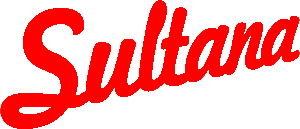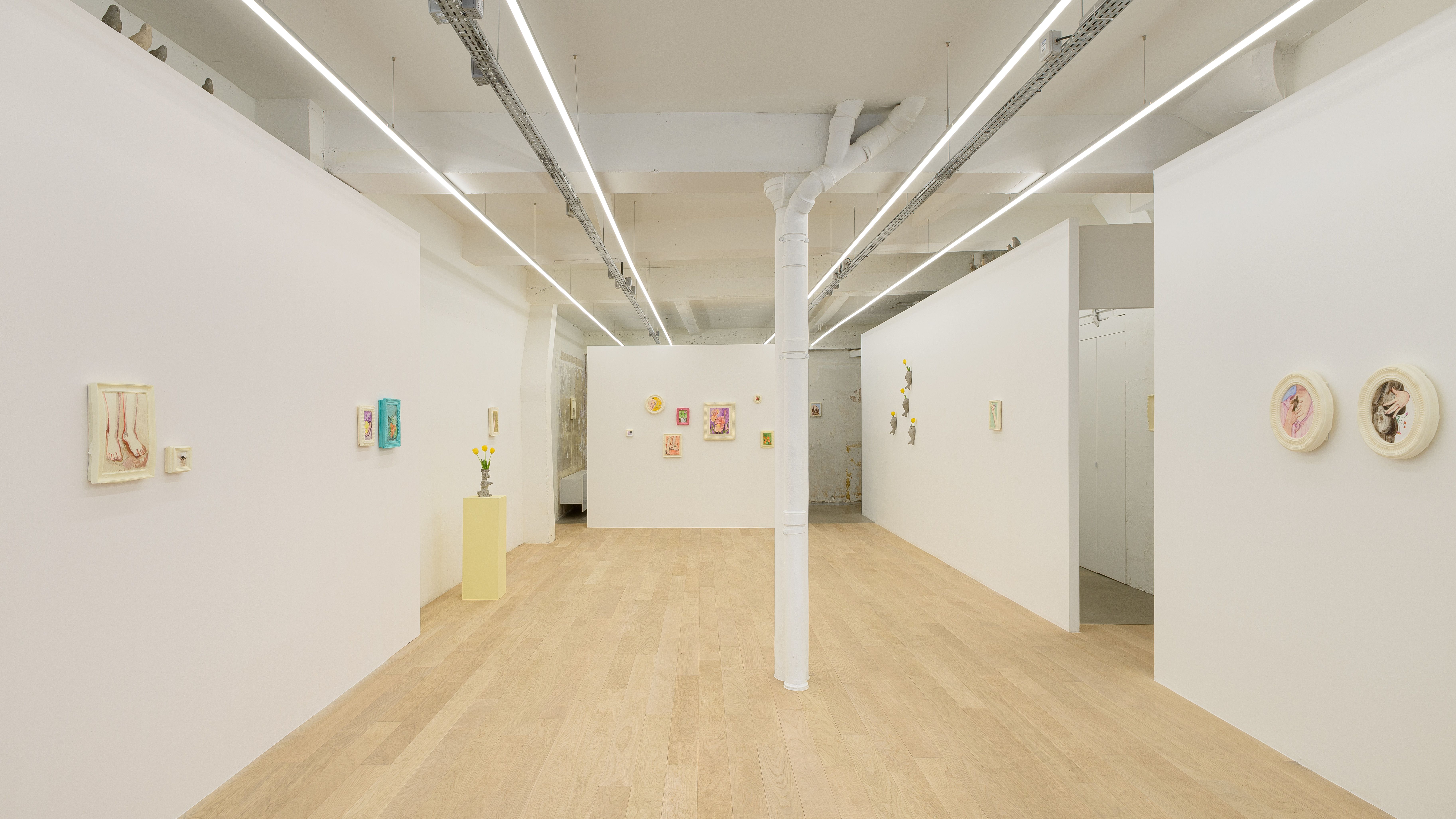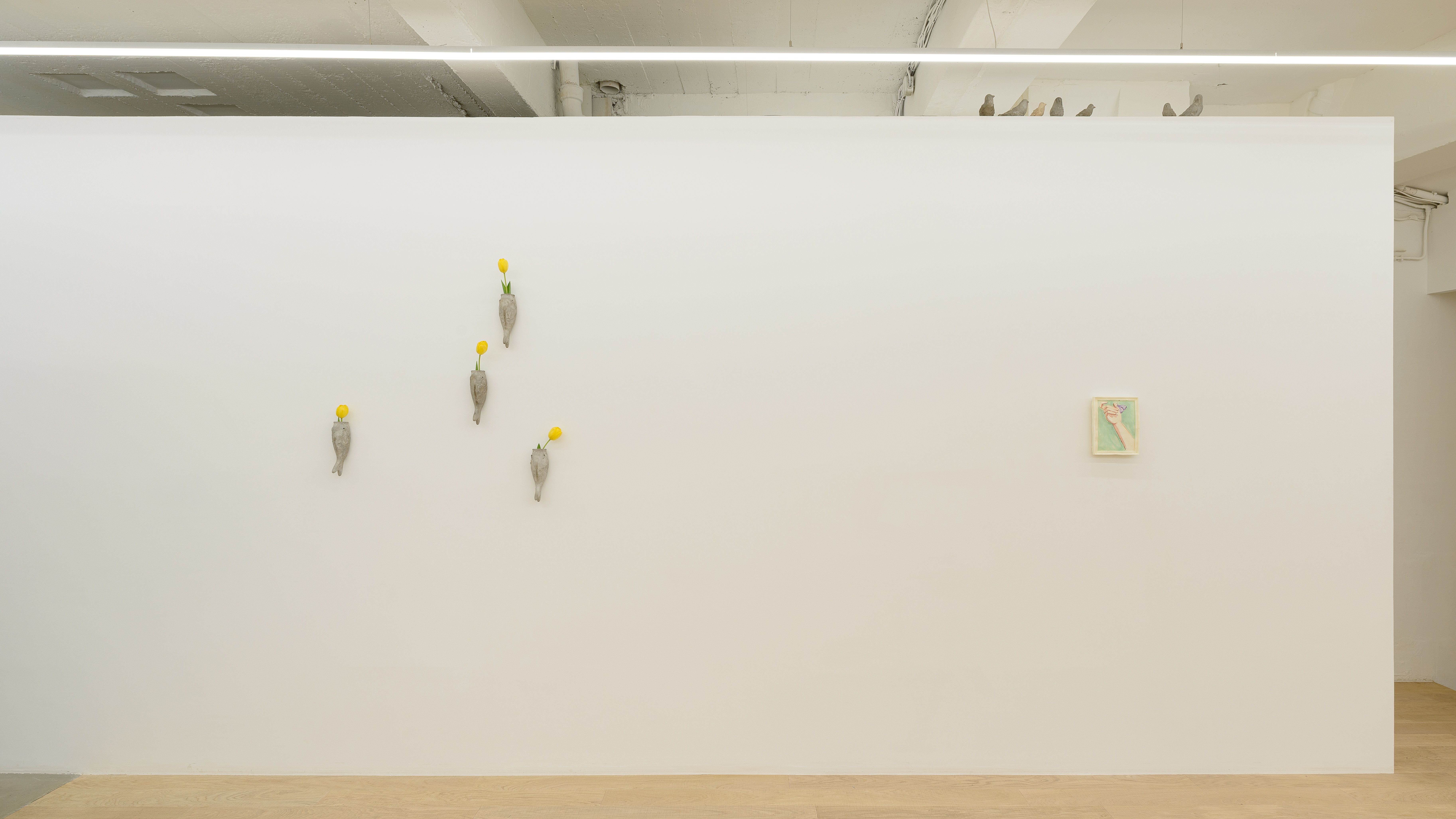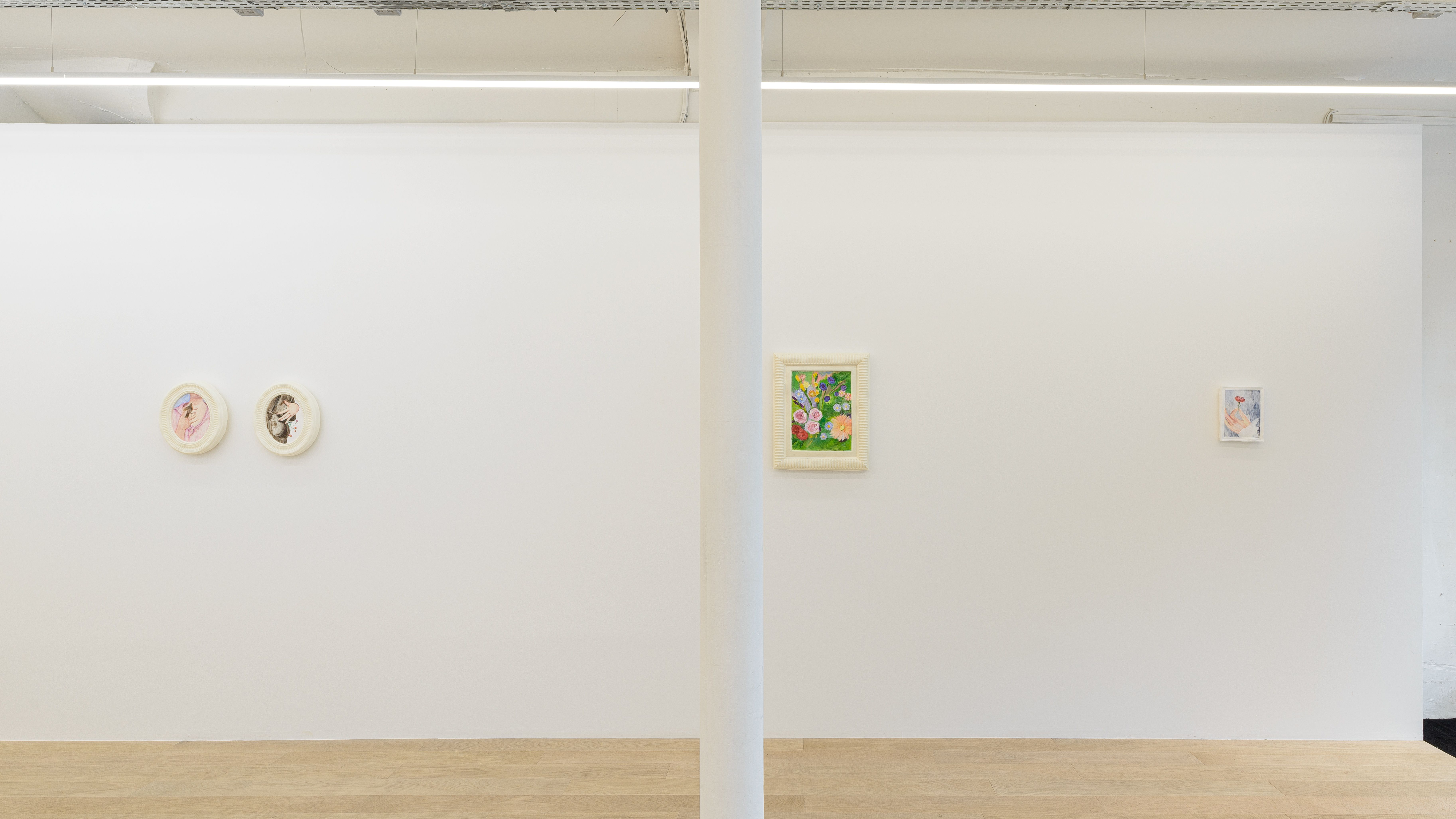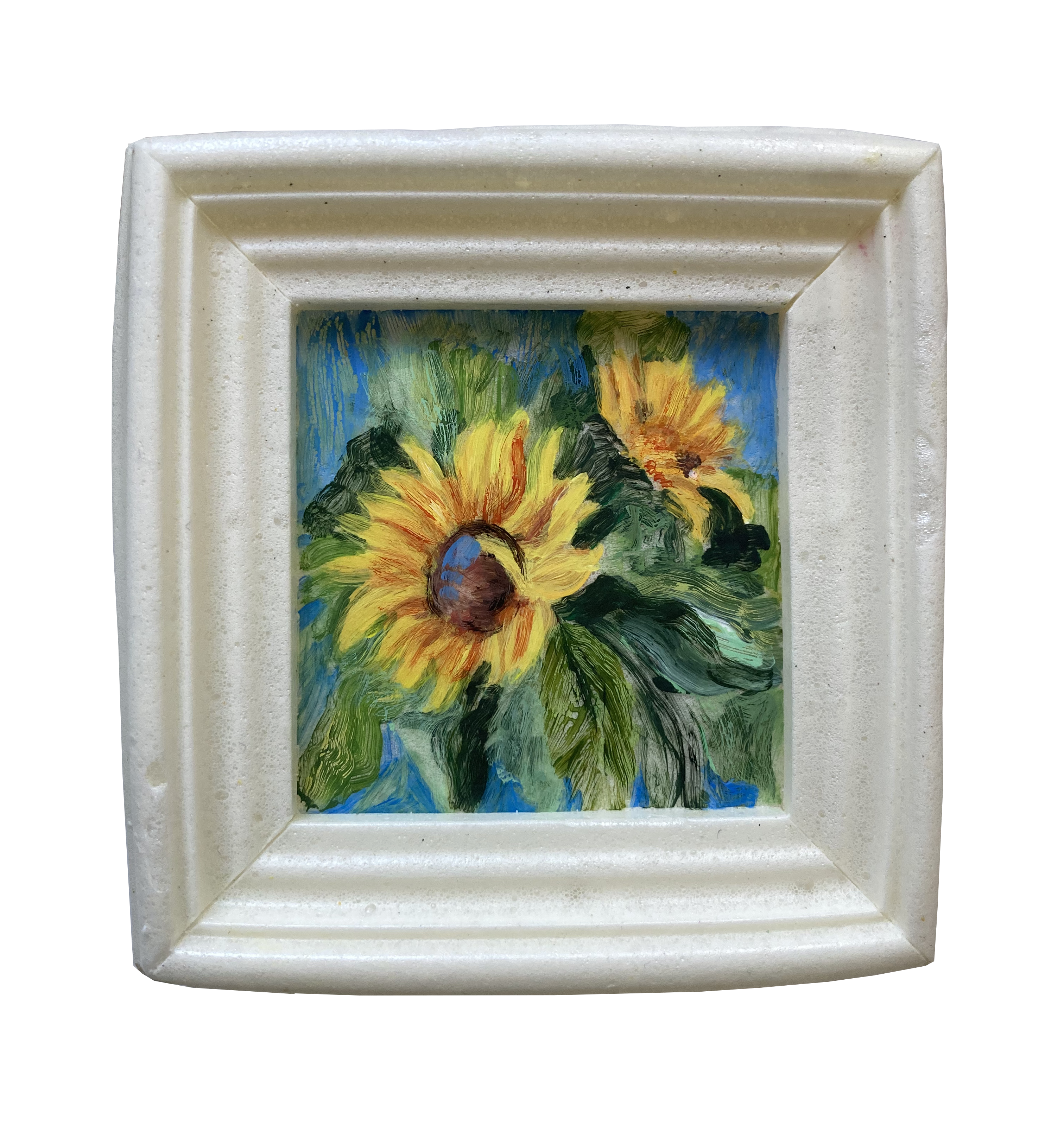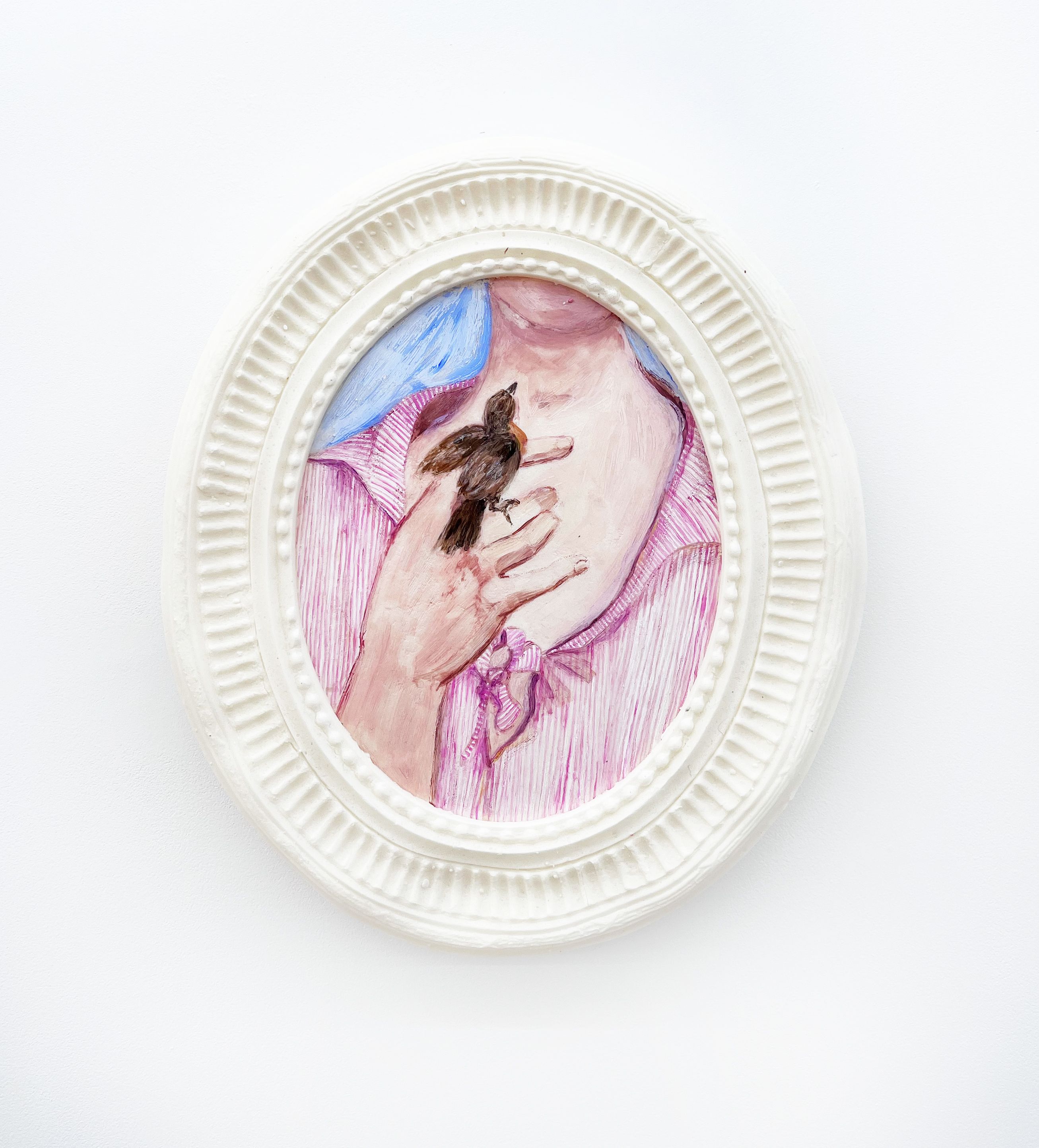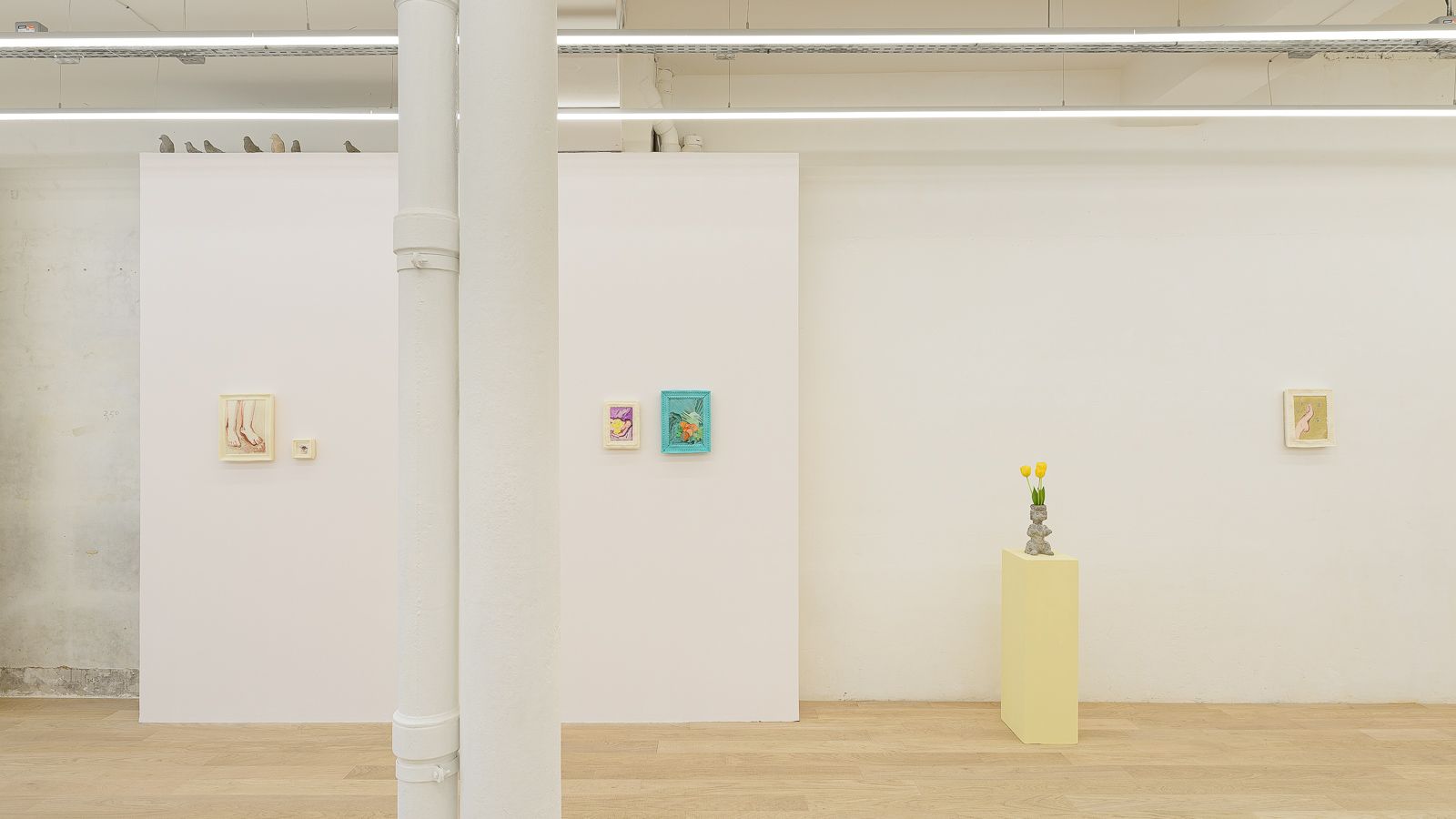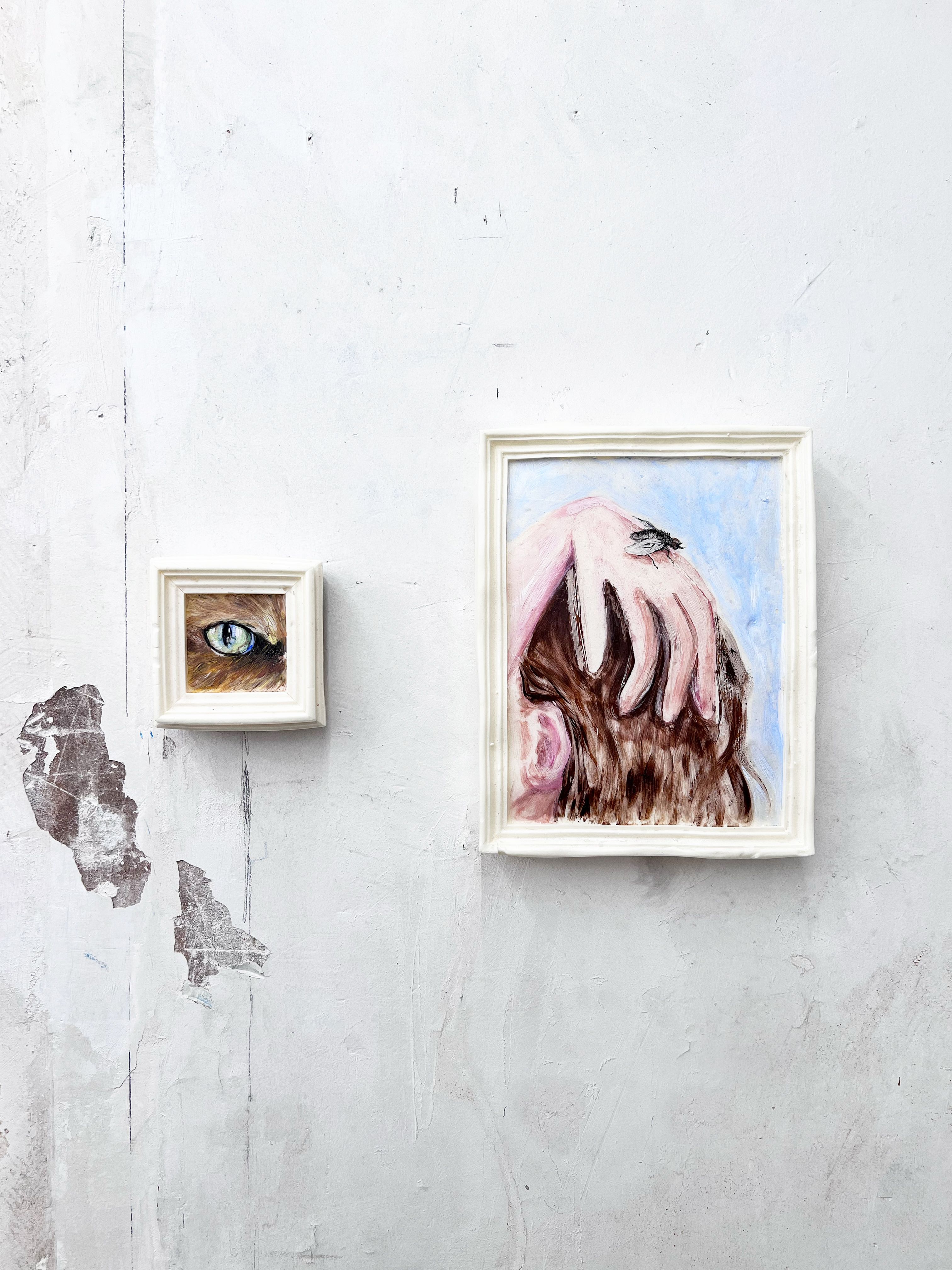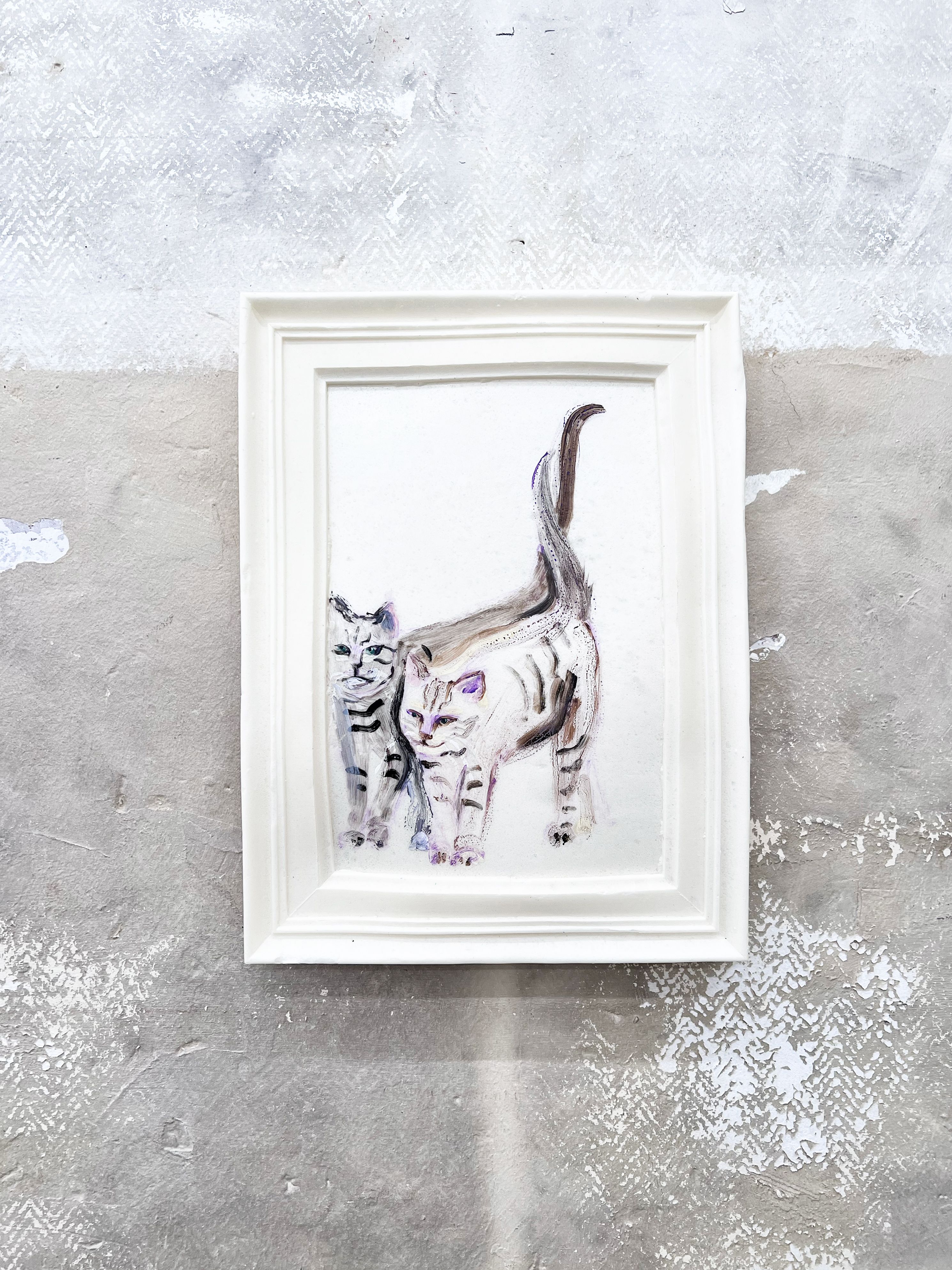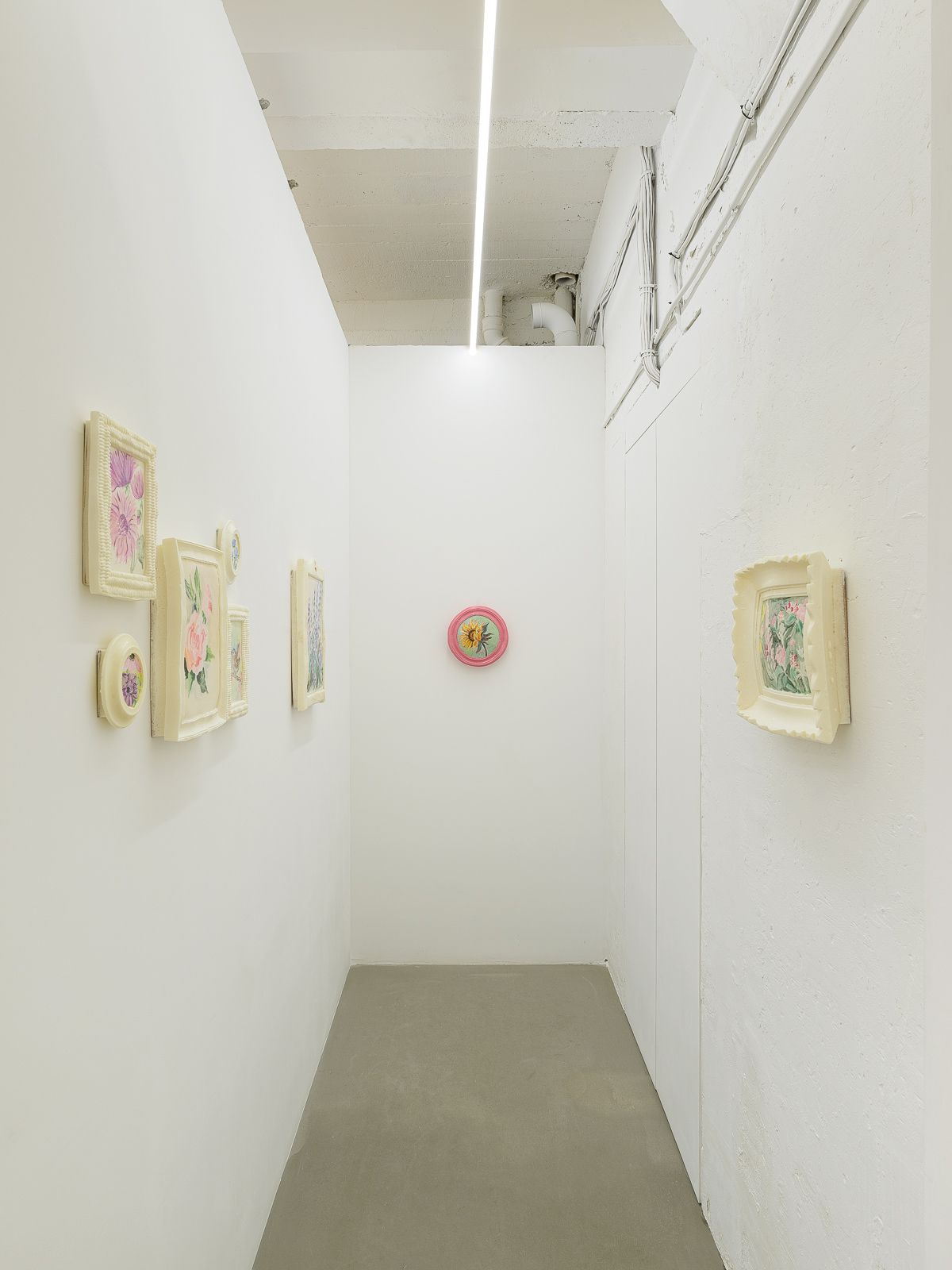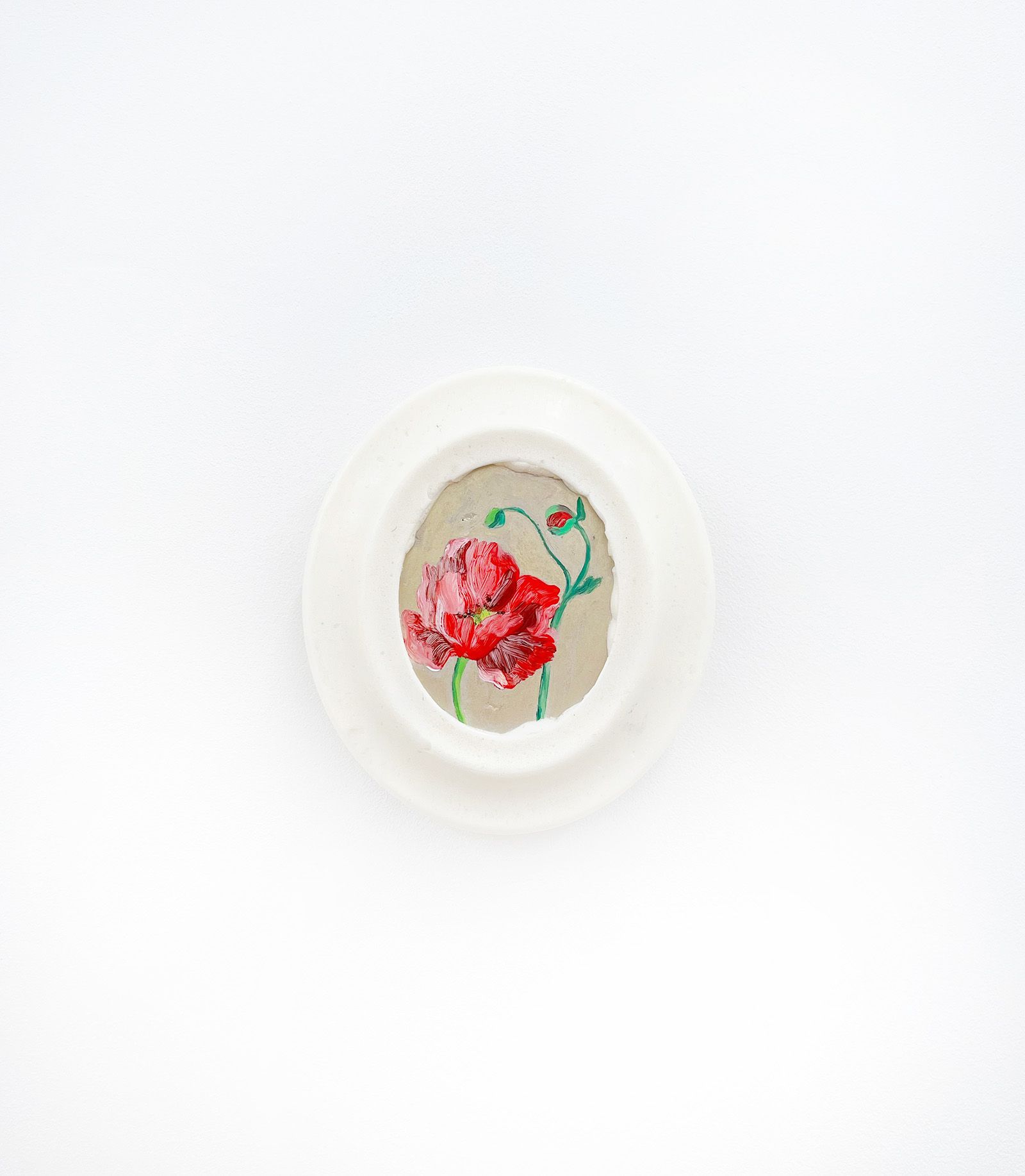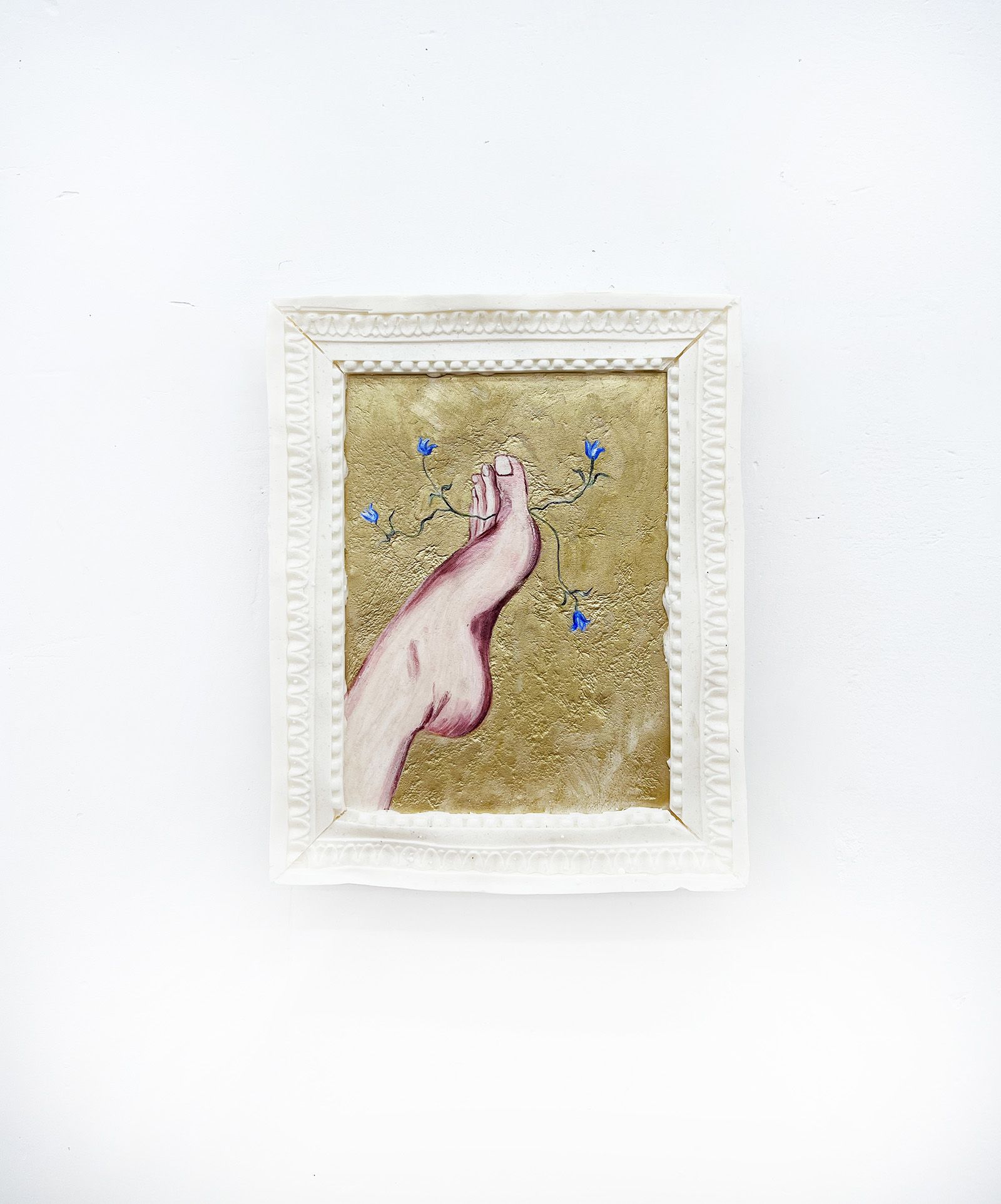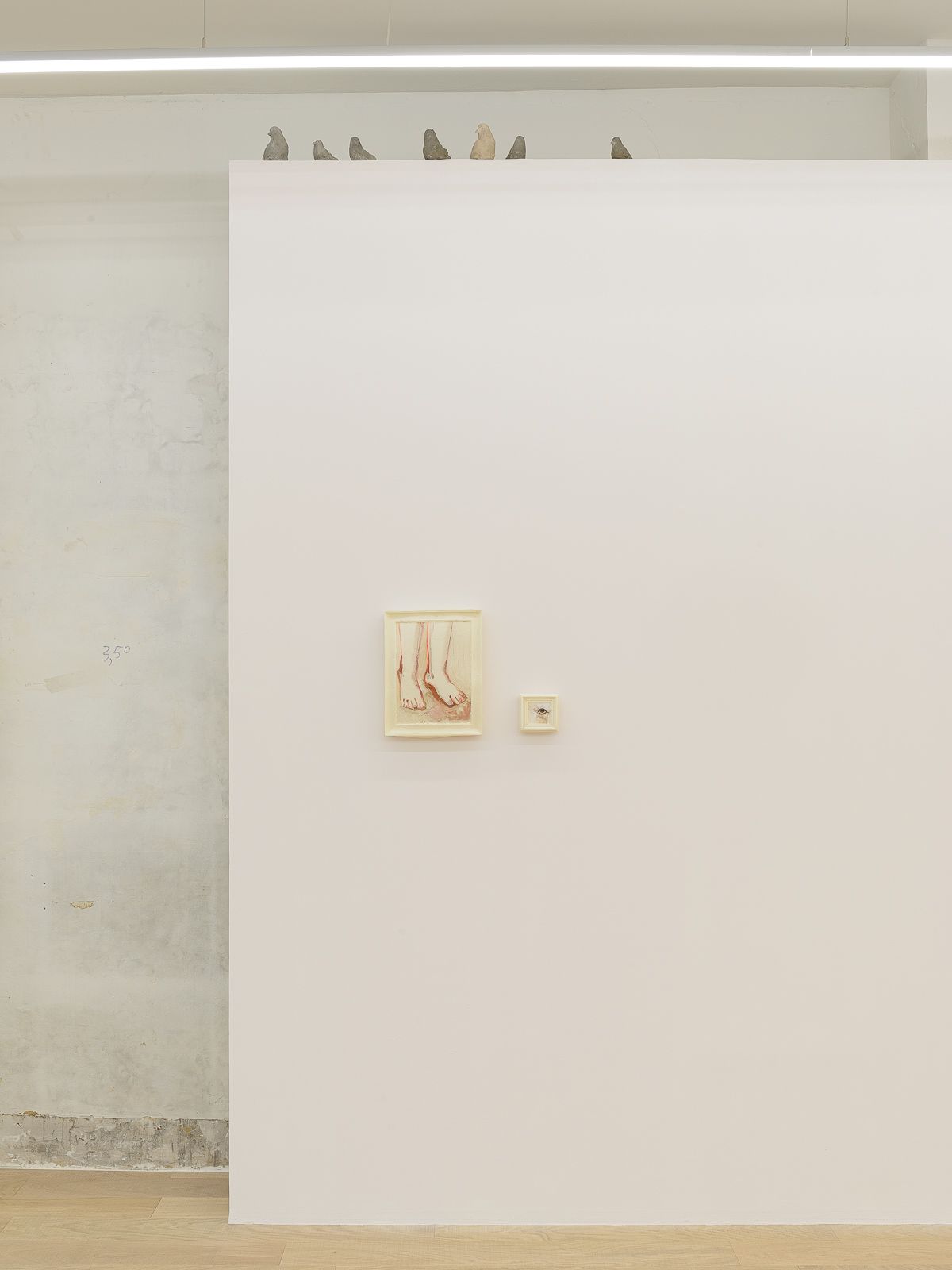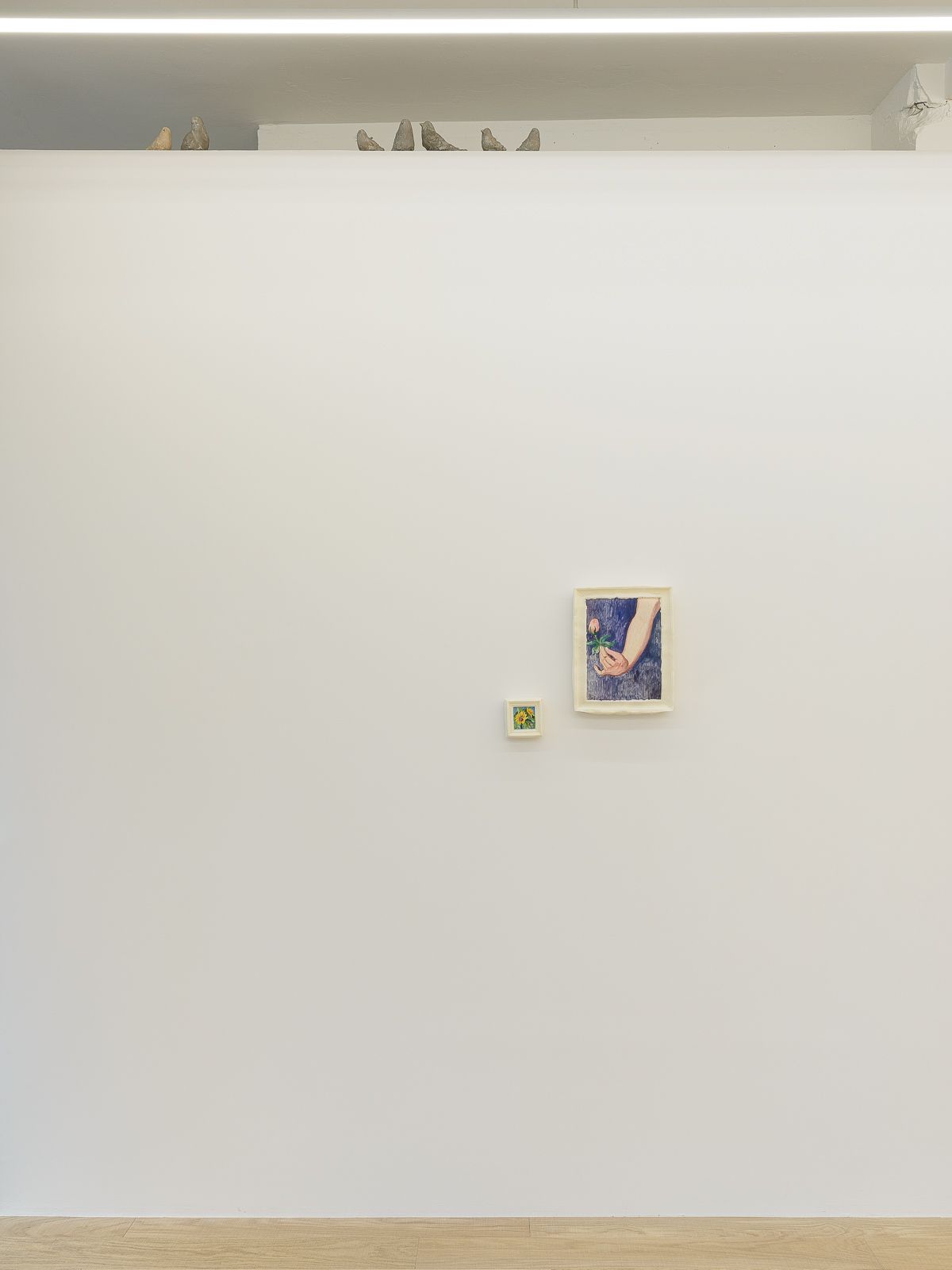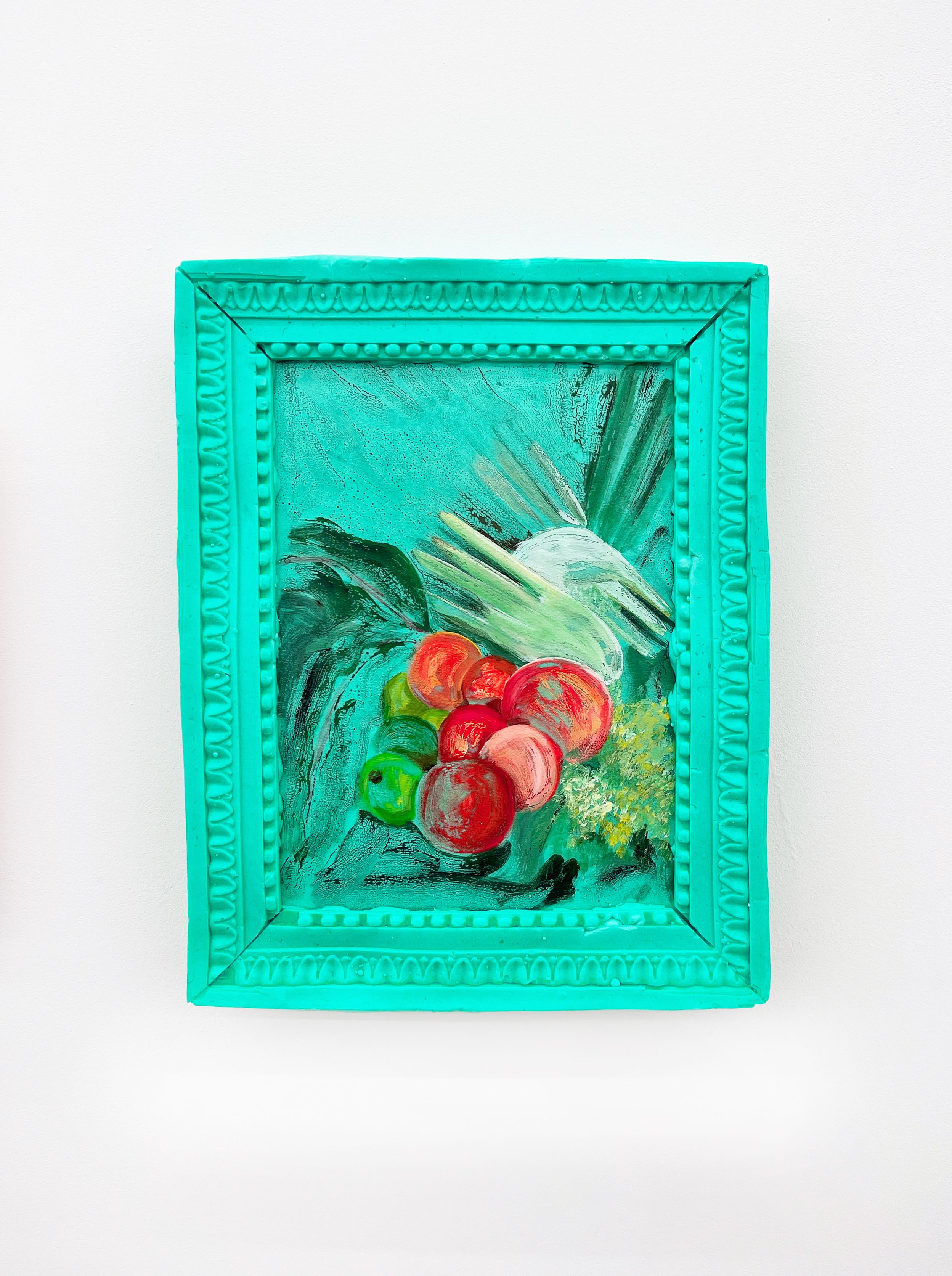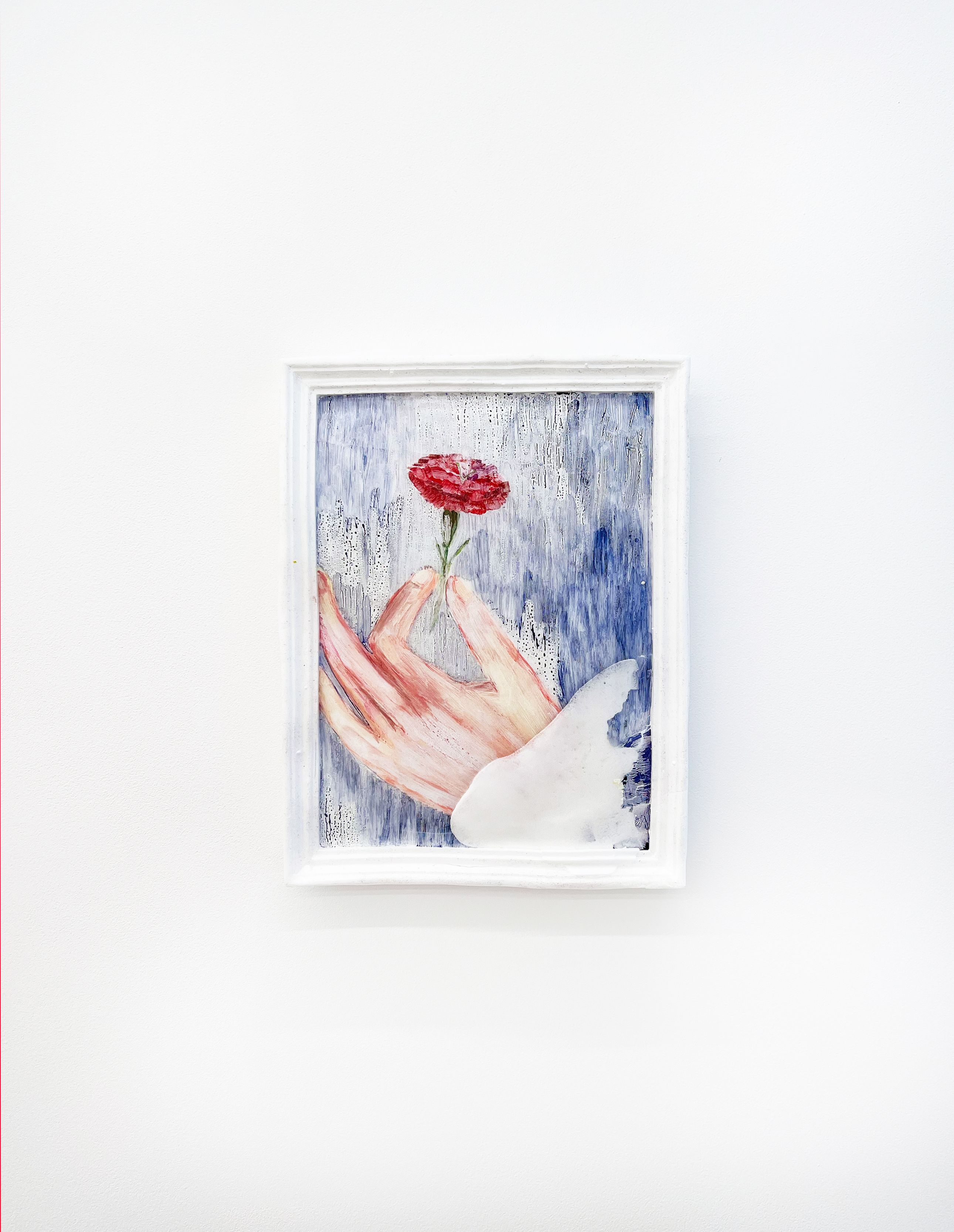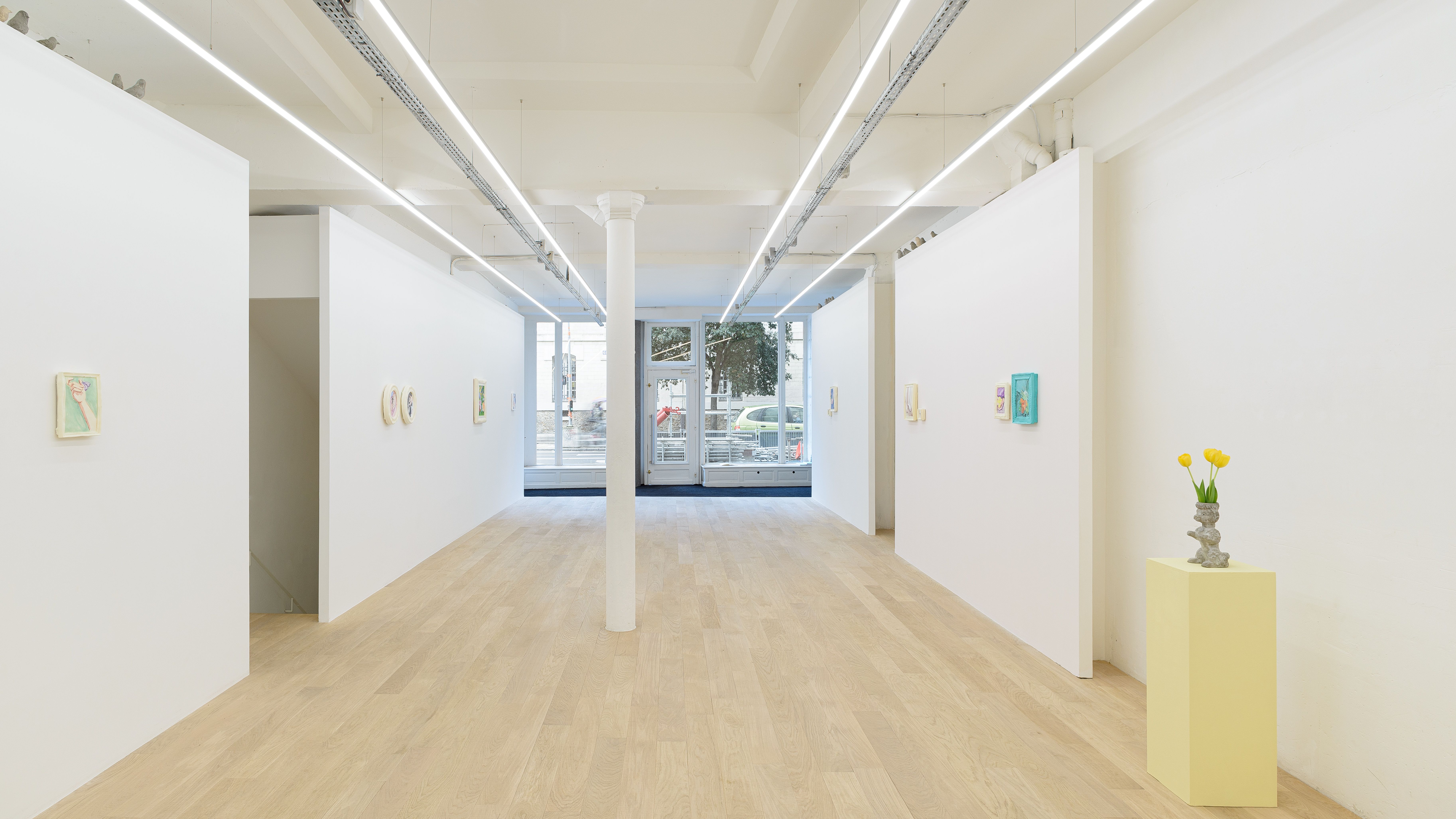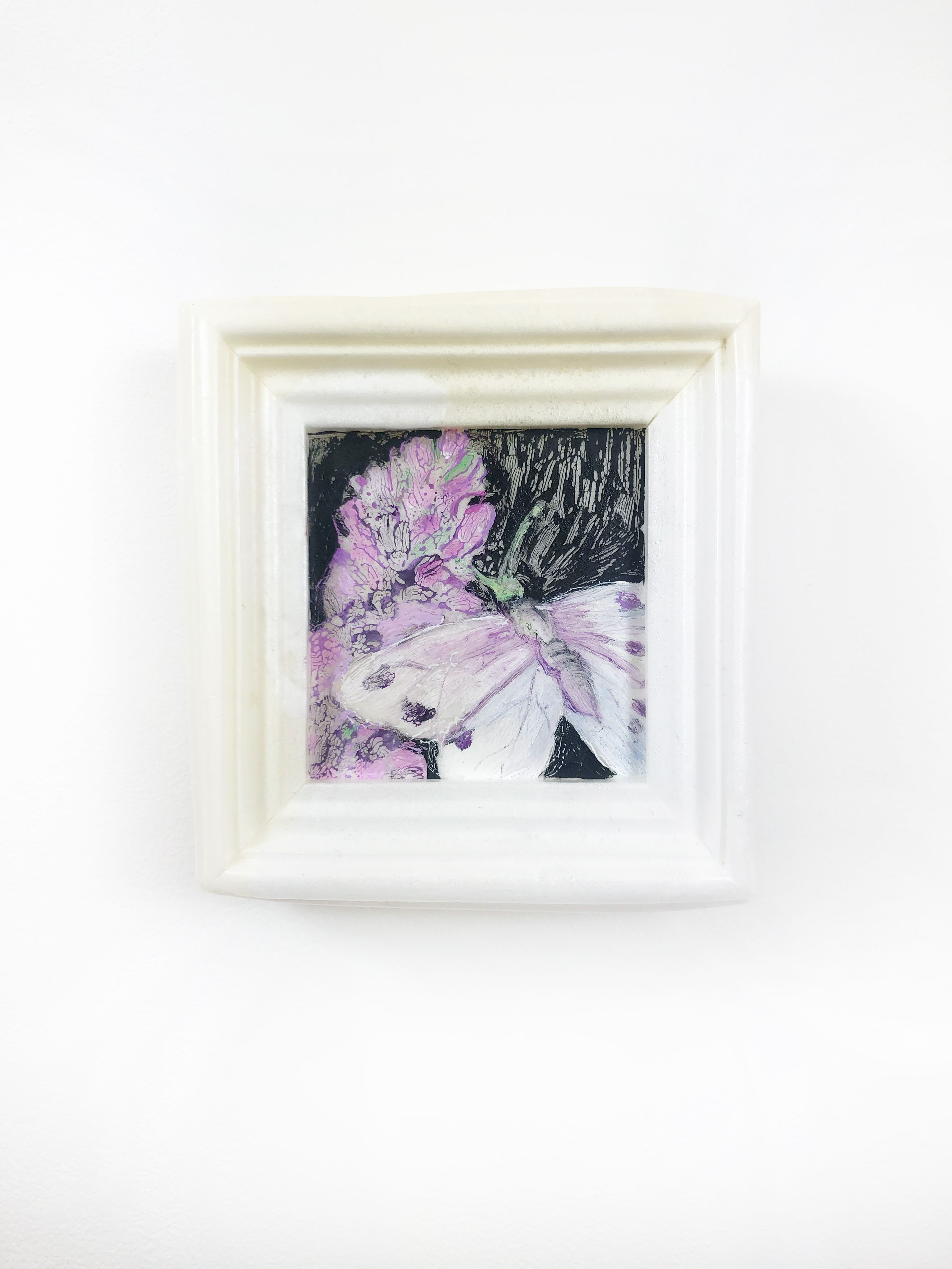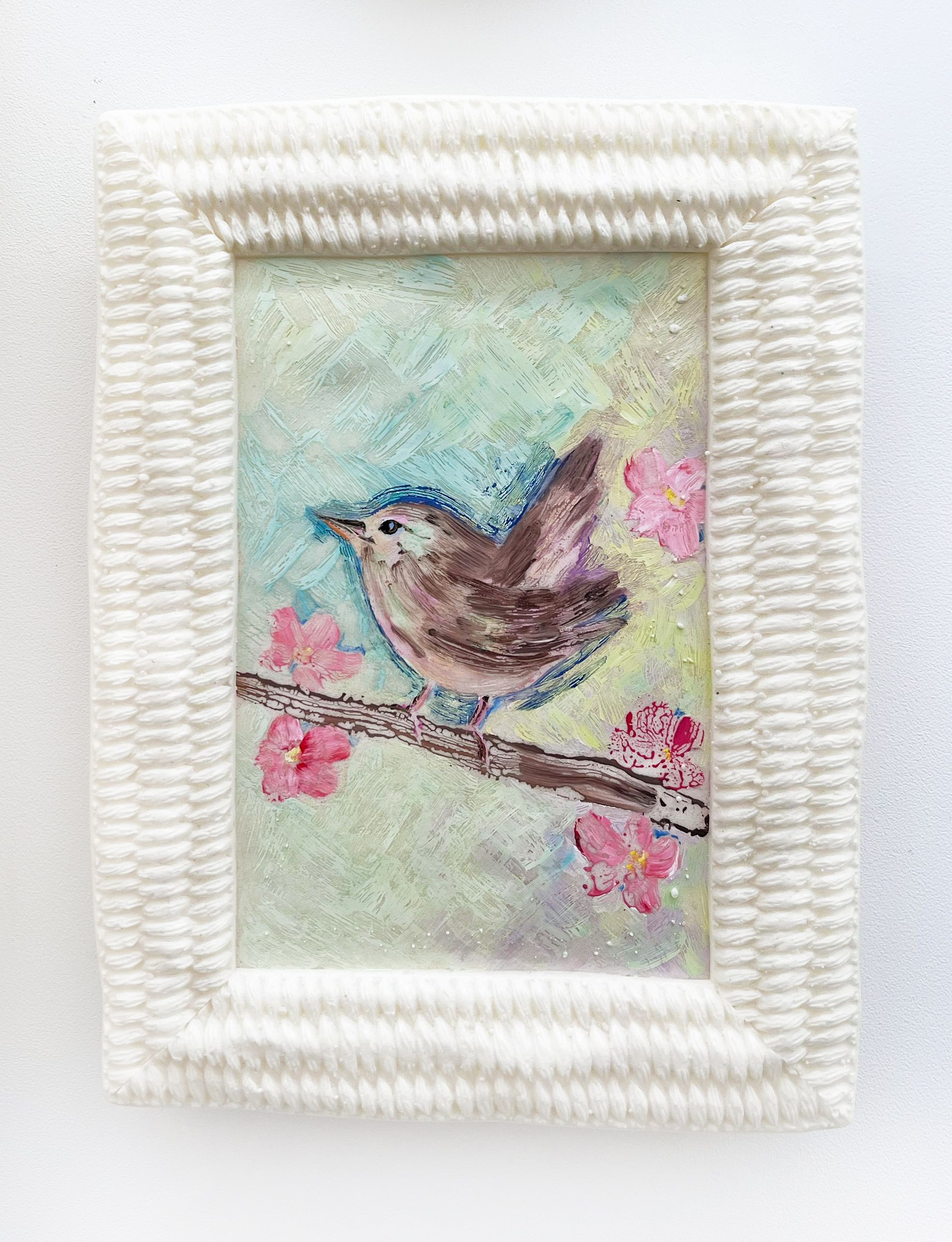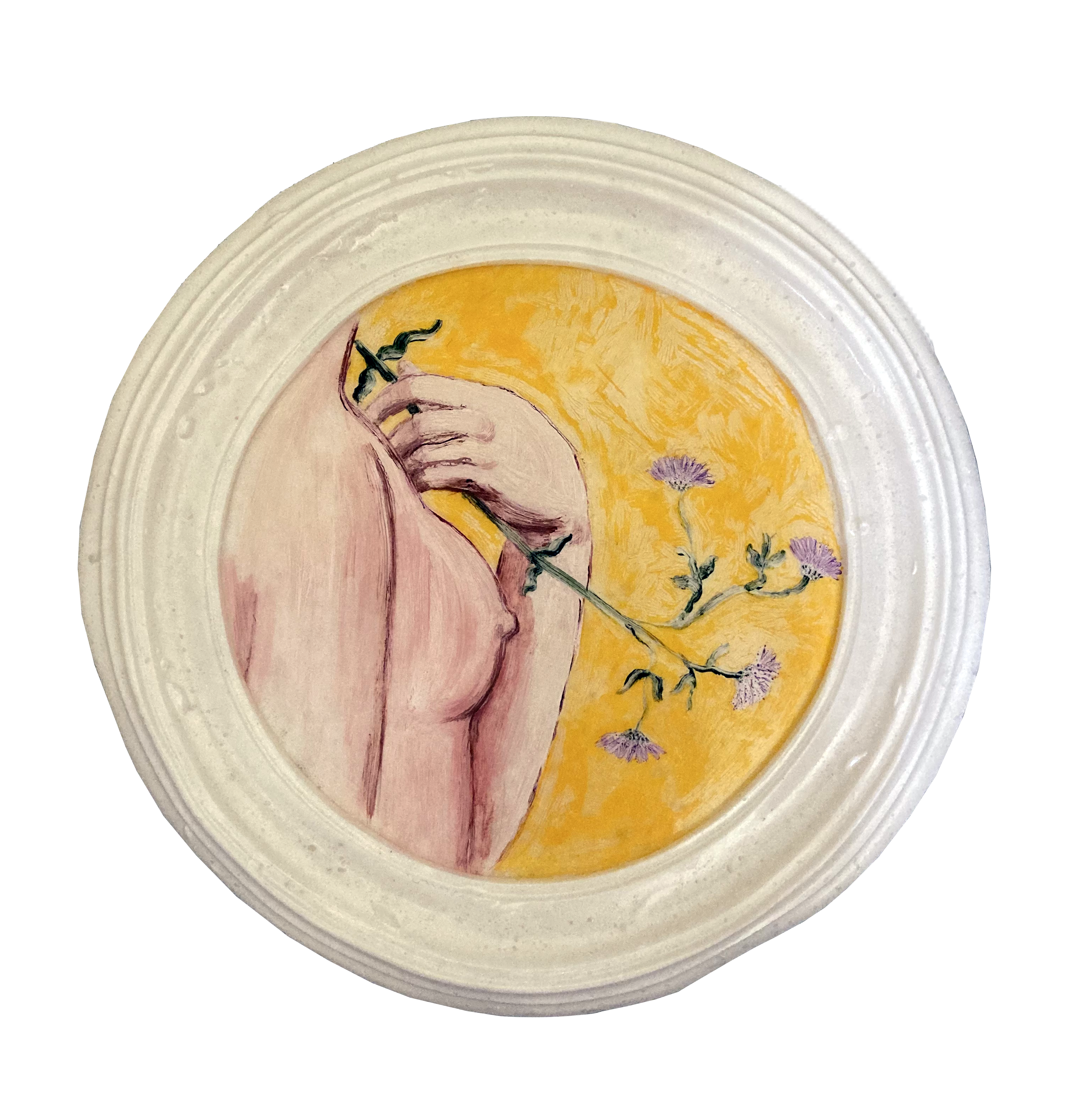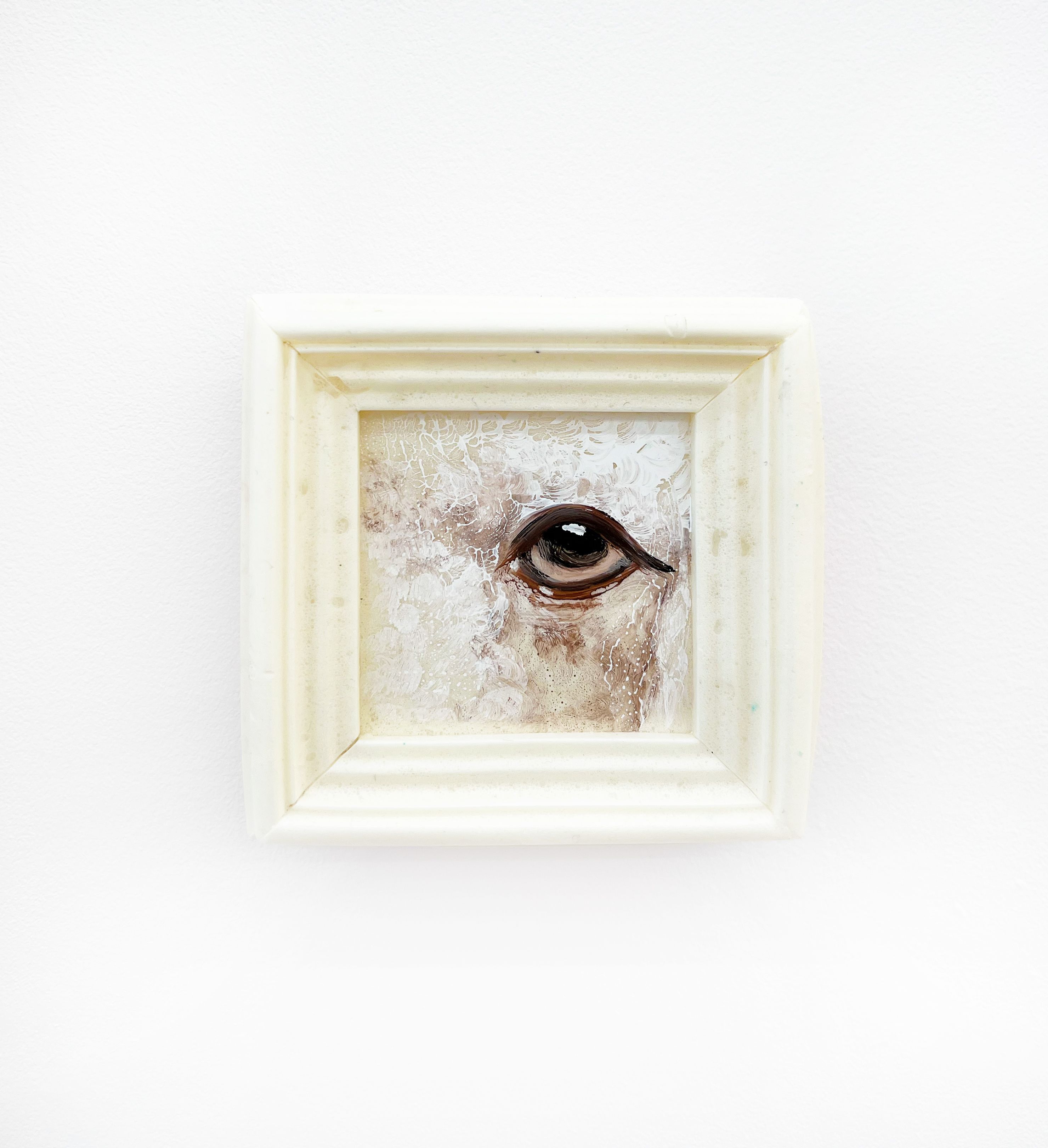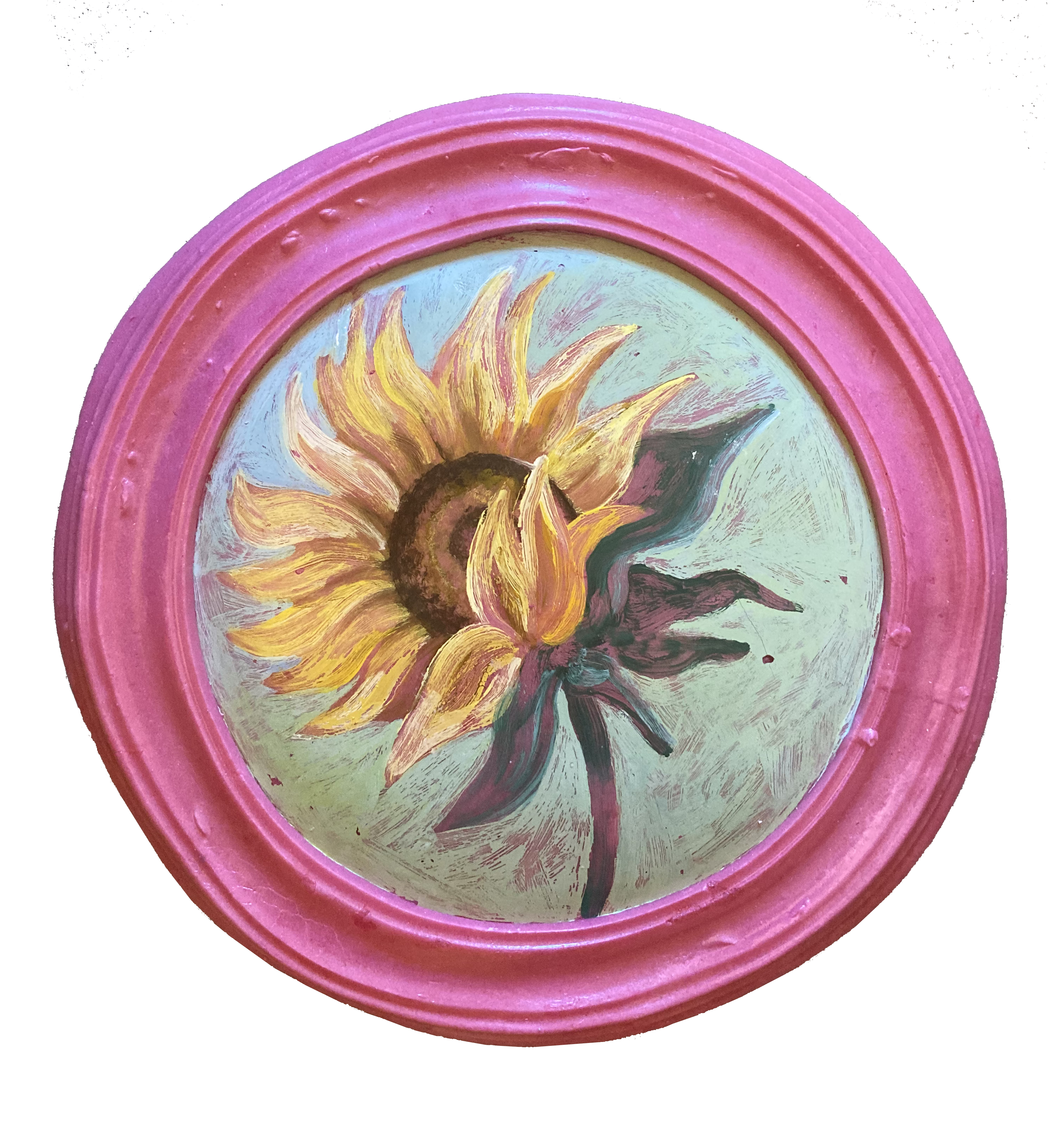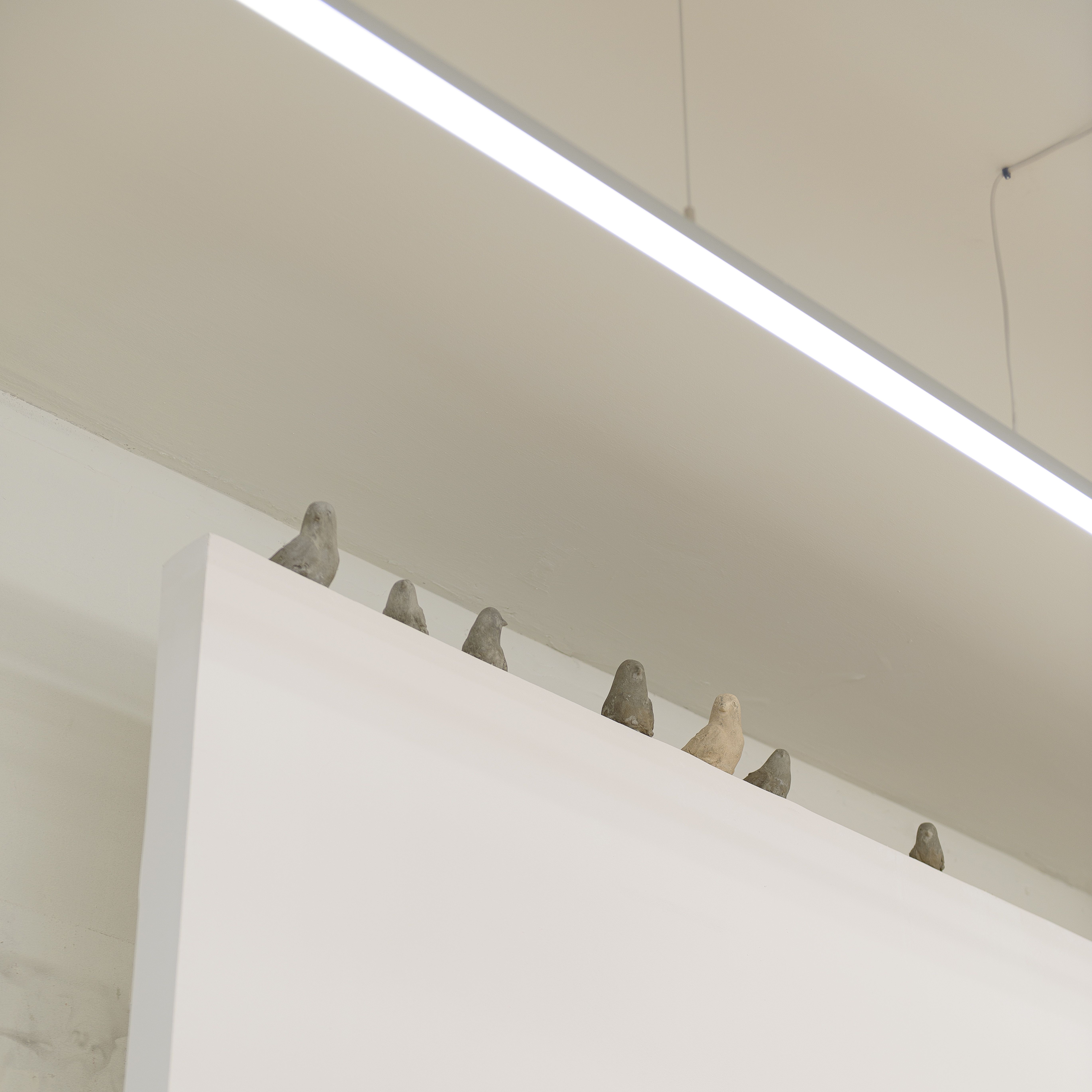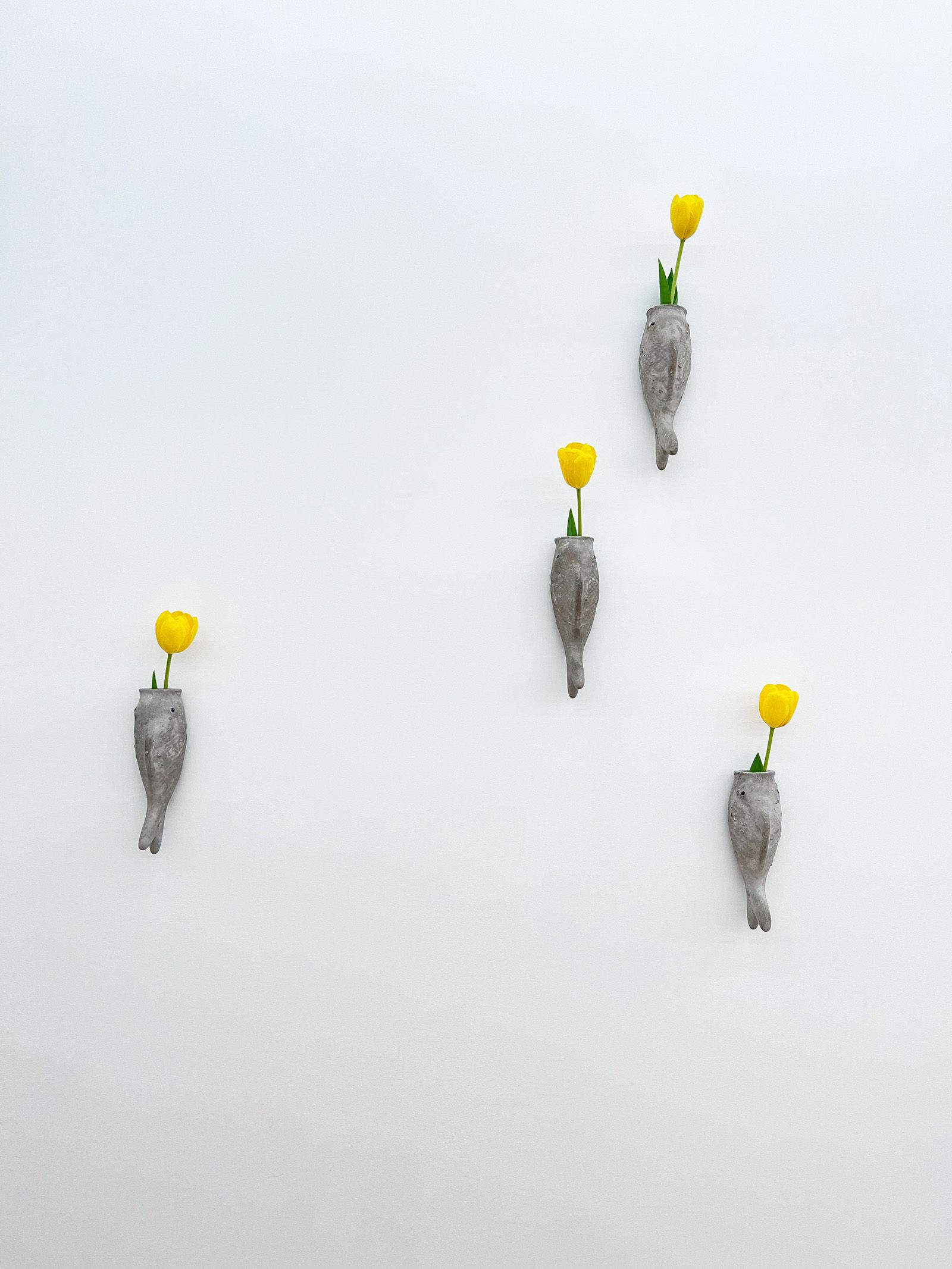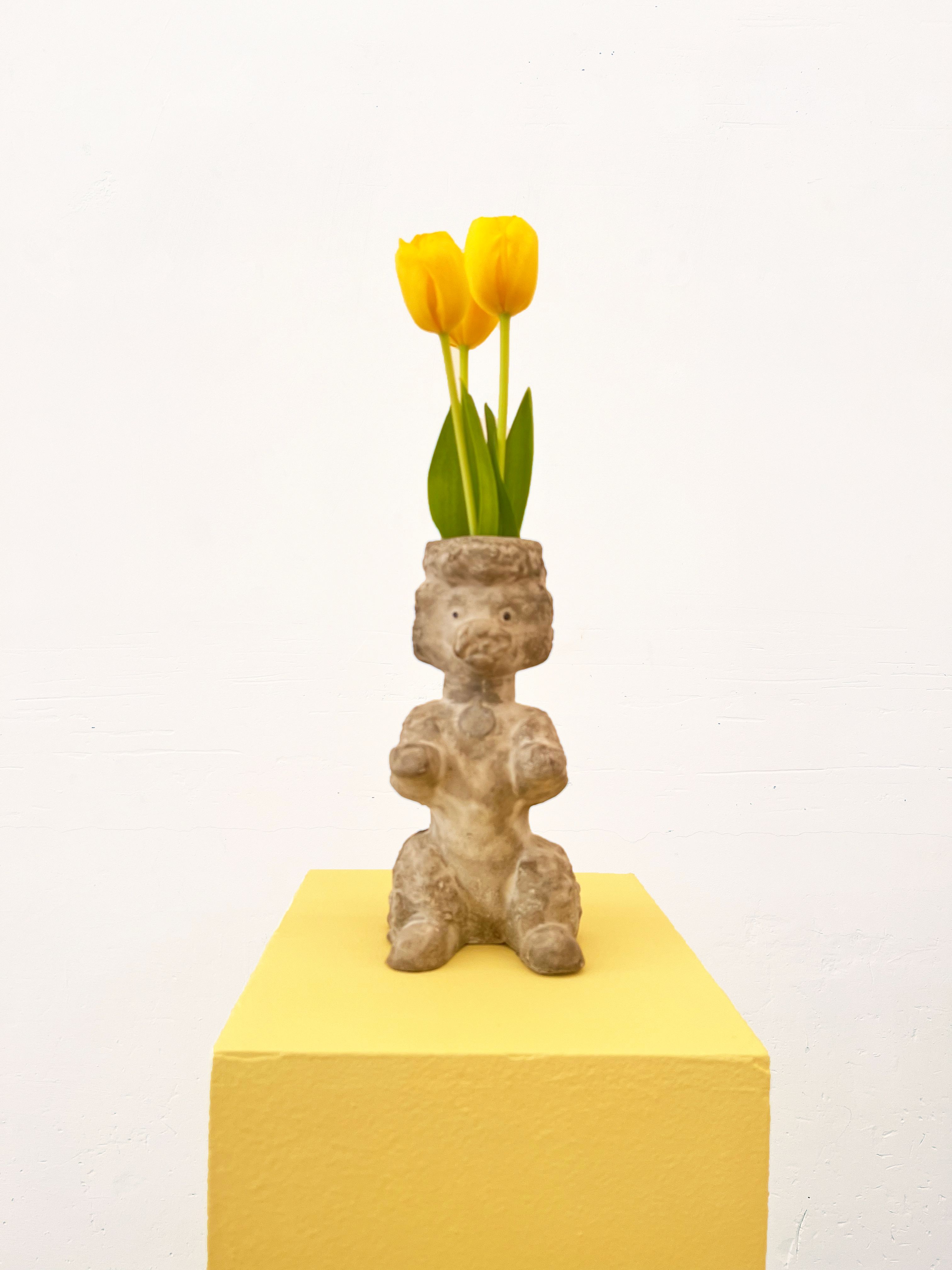Olivier Millagou conceives his latest exhibition Litmus out of the clutter that modern life exerts on the individual.
The artist reverses the narrative of our consumerist condition and ecological impact by using found material, inverting its scheme through creation. This exhibition attempts to construct exclusively with what is available, with what has no other alternative than to end up incinerated, among other waste. Out of humility, Olivier sublimes waste into poetry.
The paintings and sculptures of the show appear to be extracted from an illustration book: Birds, pets, flowers, butterflies and flies populate a world of flowery landscapes where man, when he appears, is reduced to the extremities of his body, a foot, a hand. Behind this illusory innocence, an underlying intention gives Olivier Millagou’s work a much broader and important meaning.
Olivier Millagou is a surfer. And while surfing he learned to deal with what’s available and to be satisfied with it. When the ocean offers waves you surf and where the water is still you don’t. This principle outstretches to his artistic practice: knowing how to observe, being in the right place at the right time, and seizing the opportunity when it presents itself. Litmus is entirely built with found or salvaged object, extending to the gallery space where the walls are painted with pot ends from previous exhibitions.
In 2021, Olivier Millagou moved into a 1940s house that he began to renovate. By frequenting some craftsmen and suppliers of materials, he was able to recover products whose expiration date had passed (that they do not use or no longer use for some, and that they could no longer sell for others, a question of guarantee of chemistry). Materials he had always forbidden himself to work with, because of their petrochemicals and polluting nature, were now opened to him.
Among the many objects left in the house by the previous owners, Olivier Millagou found some frames that he used as a basis for his work, molding them, without damaging them, with the expired silicon cartridges. Then he gave the frames back to live another life.
The paints and the choice of colors were made with the remains of acrylic tubes, directly on the silicone mold. This process allowed him to experiment with unique ways of painting, resulting from the particularly slippery surface of silicone. After finishing the painting, he uses a can of expired expanded foam to fill the shape of the mold. Once dry, he removes the foam which leaves the paint printed on it like a monotype, giving it that special look. And the mold becomes blank again, to be reused again and again.
The «Peintures Périmées» are inspired by the Renaissance themes of still life and memento mori: animals, flowers and insects are symbols of the fragility and irreparable damage of the Anthropocene. Like most vanities, Olivier Millagou’s works contain deep and delicate overtones that remind us of the finitude of human existence and the ephemeral nature of material life.
Sculptures, resulting from the same process, are also present in the exhibition. Vases, from the same house, are molded with expired silicone and produced with chemical sealant, also expired. On the other hand, for the bird sculptures, Olivier Millagou used wax (kerosene used to avoid slipping on the surfboard) to mold these figures before his morning surfing sessions (the wax then returning to its original function), then fired with the outdated chemical sealant.
All of these materials destined for the trash can became a poetic work of art created in what the artist calls a curative process. Curative in the sense that the processes he uses stop the moment of pollution of produced materials, whose end of life is today ineluctably the incineration.
Olivier Millagou’s art takes up the challenge of transforming waste into art without the need for dramatic expression, but with humility and deference. He interrupts artistic standards without escaping larger art historical traditions responding to the world around him with the tools he’s provided with and in tune with their potential.
Litmus (Sunflower in French) provokes an astonishing reaction of joy by the unexpected use of its materials employed and transformed into aesthetic virtues. Olivier Millagou reproduces the real as a non-fixed thing in all its mutability and confined freedom.
♡
L’encombrement qu’exerce la vie moderne sur l’individu, voilà ce qu’aborde Olivier Millagou dans son exposition Litmus.
Cette exposition est un récit, celui de notre condition : d’un consumérisme débordant, généralisé et systématique, et de son impact sur la nature. L’artiste le renverse ici en n’utilisant aucune matière neuve, et inverse ainsi ce schéma narratif par la création. Une exposition qui essaye de se faire avec peu, avec ce qui est disponible. Avec ce qui n’a pas d’autre alternative à l’heure actuelle que de finir incinéré, au milieu d’autres déchets. Avec humilité, il sublime le déchet en poésie.
Ses œuvres sont comme tirées d’un livre d’illustration. Oiseaux, animaux domestiques, fleurs, papillons et mouches peuplent un monde de paysages fleuris où l’homme, quand il apparaît, est réduit aux extrémités de son corps, un pied, une main. Derrière cette innocence, illusoire, une intention sous-jacente donne à l’œuvre d’Olivier Millagou une signification beaucoup plus large et importante.
Olivier Millagou est un surfeur, il a, de fait, très tôt été confronté à des notions liées à l’environnement. Et en surfant on apprend à faire avec ce que l’on a, et de s’en contenter. S’il y a des vagues, on peut surfer, s’il n’y en a pas, on ne surfe pas. C’est un principe qui s’étend à sa pratique artistique. Savoir observer, être au bon endroit au bon moment et saisir l’opportunité lorsqu’elle se présente. S’il y a des matériaux, il peut produire, s’il n’y en a pas, il ne produit pas. L’exposition Litmus, est entièrement créée à partir des objets et des matériaux trouvés ou récupérés, jusqu’à l’espace même de la galerie, dont les murs sont peint avec des restes de peintures des expositions précédentes.
En 2021, Olivier Millagou s'installe dans une maison des années 1940 qu'il entreprend de rénover. En fréquentant quelques artisans et fournisseurs de matériaux, il a pu récupérer des produits dont la date de péremption était dépassée (qu’ils n’utilisent pas ou plus pour les uns, et qu’ils ne pouvaient plus vendre pour les autres, une question de garantie de la chimie). Ce sont ouvert à lui des matières qu’il s’était toujours interdit de travailler, car issus de la pétrochimie et donc très polluants.
Parmi les nombreux objets laissés par les précédents propriétaires dans la maison, Olivier Millagou a trouvé des cadres qu'il a utilisés comme base de travail, en les moulant, sans les endommager, avec les cartouches de silicones périmées. Ensuite, il a redonné les cadres pour qu’ils vivent une autre vie.
Les peintures et le choix des couleurs se sont faits avec des restes de tubes acryliques, directement sur le moule en silicone. Ce procédé lui a permis d’expérimenter des manières de peindre singulières, résultant de la surface particulièrement glissante du silicone.
Après avoir terminé la peinture, il utilise une bombe de mousse expansée périmée pour remplir la forme du moule. Une fois sèche, il retire la mousse qui laisse la peinture imprimée dessus comme un monotype, ce qui lui donne cet aspect si particulier. Et le moule redevenant vierge, peut à nouveau être utilisé plusieurs fois.
Les "Peintures Périmées" s'inspirent des natures mortes et des memento mori à partir de la Renaissance. Les animaux, les fleurs et les insectes sont autant de symboles de la fragilité et des dommages irrémédiables de l'Anthropocène. Comme la plupart des vanités, les œuvres d'Olivier Millagou contiennent de profondes et délicates connotations qui nous rappellent la finitude de l’existence humaine et la nature éphémère de la vie matérielle. Ces choses sensibles et belles que les matériaux qui constituent ces peintures, détruisent petit à petit.
Des sculptures, issues du même procédé, sont aussi présentes dans l’exposition. Des vases, issus de cette même maison, sont moulés avec le silicone périmé et produits avec du scellement chimique, périmé lui aussi.
En revanche pour les sculptures d’oiseaux, Olivier Millagou a utilisé de la wax (paraffine utilisée pour ne pas glisser sur la planche de surf) pour mouler ces figures avant ses séances de surf matinales (la wax retournant ensuite à sa fonction première), puis tirées avec le scellement chimique périmé.
Tous ces matériaux destinés à la poubelle sont devenus une œuvre poétique réalisée dans ce que l'artiste appelle une démarche curative. Curative dans le sens où les procédés qu’il emploie stoppent l’instant d’une pollution de matériaux produits, dont la fin de vie est aujourd’hui inéluctablement l’incinération. L'art d'Olivier Millagou relève le défi de transformer les déchets en art sans avoir besoin d'une expression dramatique, mais avec humilité et déférence. Il interrompt les normes artistiques sans échapper aux grandes traditions de l'histoire de l'art, en réagissant au monde qui l'entoure avec les outils dont il dispose et en accord avec leur potentiel. Litmus (Tournesol en français) provoque une étonnante réaction de joie par l'utilisation inattendue de ses matériaux employés et transformés en vertus esthétiques. Olivier Millagou reproduit le réel comme une chose non fixée dans toute sa mutabilité et sa liberté confinée.
